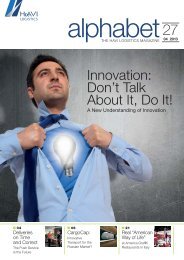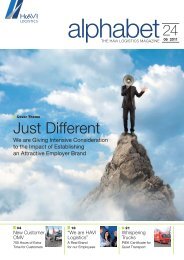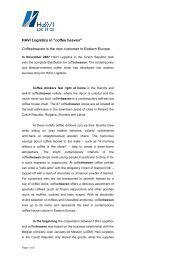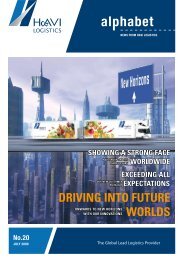1595,0 kB - Media Center - HAVI Logistics
1595,0 kB - Media Center - HAVI Logistics
1595,0 kB - Media Center - HAVI Logistics
Create successful ePaper yourself
Turn your PDF publications into a flip-book with our unique Google optimized e-Paper software.
eAl beAuty comes<br />
from iNside<br />
Total Quality Management (TQM) is not practicable for many companies<br />
in a fast-moving business world with expectations of short-term<br />
profits. They cannot conceive of quality as a corporate philosophy. It has always been clear to <strong>HAVI</strong> <strong>Logistics</strong><br />
that a company’s external image results from the quality of its work. After all, a good character is attractive or,<br />
in other words, real beauty comes from inside.<br />
tQm Is tHe nAme given to the thorough<br />
and continuous activity of recording, inspecting,<br />
organizing and monitoring all<br />
areas of a company, which introduces quality<br />
as a goal of the system and guarantees<br />
it in the long term. However, TQM is not an<br />
independent system of management, a standard<br />
or a law. TQM means striving to make all<br />
the company’s products and services market<br />
leaders. This is done with the aid of all the<br />
existing parts of the management system –<br />
such as quality management, environmental<br />
management, safety management and human<br />
resources management – quality techniques<br />
and methods for initiating a company-wide<br />
improvement process. TQM requires<br />
the full support of all employees if it is going<br />
to bear fruit.<br />
sInce our compAny wAs founded in<br />
1981, TQM has been an integral part of <strong>HAVI</strong><br />
<strong>Logistics</strong>’ corporate culture. TQM – actually<br />
a child of the 1940s – did not reach European<br />
shores until 1988. It was invented in the<br />
USA by “William Edwards Deming”. But after<br />
the end of the Second World War no one<br />
bothered to pay it any attention because the<br />
focus was on maximizing production volume<br />
in view of the reduced global production<br />
capacities after the War. In war-torn Japan,<br />
on the other hand, Deming’s work met with<br />
more success. Here, Total Quality Management<br />
rapidly became a highly regarded ma-<br />
Cover Story<br />
nagement philosophy; as early as 1951 the<br />
first Japanese company won the “Deming-<br />
Award” for especially high quality standards.<br />
In the decades that followed, the Japanese<br />
Quality checks throughout the whole supply<br />
chain are part of our corporate culture and influence<br />
the daily activity of all the staff.<br />
conquered larger market shares all around<br />
the world with their high-quality, keenly priced<br />
products. They were so successful that<br />
even US companies looked at what Japan<br />
was doing and discovered Deming’s quality<br />
philosophy. It was finally applied by renowned<br />
companies in the USA in the 1970s and<br />
1980s. Then at the end of the 1980s TQM<br />
finally also arrived in Europe.<br />
03<br />
tHe mAIn prIncIpLes of tHe tQm-<br />
pHILosopHy IncLude:<br />
■ Quality is based on the wishes of the<br />
customer.<br />
■ Quality is achieved with input from the<br />
employees at all units and levels.<br />
■ Quality comprises several dimensions<br />
that have to be operationalized by app-<br />
lying certain criteria.<br />
■ Quality is not a goal but a never-ending<br />
process.<br />
■ Quality refers not only to products, but<br />
also to services.<br />
■ Quality requires active participation and<br />
hard work.<br />
The fundamental idea is that quality management<br />
should not be restricted to the technical<br />
functions for ensuring product quality,<br />
but to the relationship between the company<br />
and its customers. The top priority is customer<br />
satisfaction, which can only be achieved<br />
in the long term through sustainable development<br />
of the company itself.<br />
>> continued on page 04















